223,380 Dials. 615 Meetings. Do Your Numbers Compare?
Cold Call Benchmarks for August 11-15, 2025
📊 Weekly Snapshot
Total Dials: 223,380
Total Connects: 13,373 (5.98% connect rate)
Conversations: 3,718 (27.8% of connects)
Meetings Booked: 615 (16.5% conversation-to-meeting rate)
👉 That means it took roughly 363 dials to land one meeting last week.
Why it matters: This is the real benchmark SDR managers should coach against. It’s not just about dialing volume—it’s about getting more value from each connect.
🔑 Key Trend: Connects Are Up, But “Not Interested” Is the Wall
42.5% of conversations ended with “Not Interested.”
Only 6.1% of conversations resulted in a booked meeting.
The most common “next step” ask was “Call me back later” (11.3%) or “Send me an email” (7.2%).
📌 Interpretation: Connects are happening, but reps are losing momentum once live. Prospects aren’t outright hostile—they’re open to follow-ups (calls, emails, later timing). This signals messaging gaps, not pipeline failure.
Recommendation:
Build structured follow-up cadences off call outcomes. For example:
“Call back later” → auto-schedule next dial.
“Send email” → pre-built templates that reference the call.
Run team training on first 30 seconds frameworks: curiosity hooks, tailored insights, credibility drops.
⚡ Quick Win: Shorter Calls = Faster Wins
Average meeting-setting call length: ~4.5 minutes (269 seconds).
Shortest call with a meeting set: 31 seconds.
Longest call with a meeting set: 34 minutes.
👉 Translation: You don’t need a perfect 10-minute discovery to book meetings. High-performers are planting just enough value to secure time on the calendar, not running full demos.
Manager Coaching Tip: Teach reps the “2-Minute Value Pitch”:
Lead with a relevant pain.
Share a quick proof point.
Ask for the meeting before the conversation drags.
🚧 Common Challenge: Monday Peaks, Friday Slumps
Best day for connects: Monday (32% of weekly connects).
Worst day: Friday (14.6%).
Wednesday onward sees a sharp decline.
Tactical Play:
Stack new prospecting blocks on Mondays and Tuesdays.
Use Thursdays/Fridays for follow-ups, nurturing, and warmer touches instead of brute-force dialing.
🛠️ Efficiency Drivers: Dialer Settings Matter
Best connect rates came from 3–5 parallel dials (accounting for 71% of all connects).
Teams not using auto-rotation or dialing fewer lines saw materially lower connect and meeting rates.
👉 Salesfinity AI Dialer isn’t just removing admin drag—it’s amplifying connect opportunity density. That gives reps more shots on goal, which magnifies the importance of skill + follow-up execution.
💡 Short Tip: The 3F Rule for Follow-Ups
When a prospect asks for a callback or email, reps should act within 3F: Fast, Friendly, and Framed.
Fast: Follow up within 24 hours.
Friendly: Keep tone warm, not robotic.
Framed: Reference the exact call moment (“When you asked me to…”).
This alone can turn 10–15% of “not now” responses into meetings.
🎯 Action Step for Sales Leaders
This week: Run a call review session focused only on the first 45 seconds of conversations.
Listen to how reps open.
Track how often “Not Interested” is triggered in the first exchange.
Coach reps to swap feature-first intros with pain-based, curiosity-driving hooks.
📈 How to measure success: If “Not Interested” rates drop even 10% over two weeks, you’ll see a meaningful lift in meetings set without increasing dial volume.
🚀 Multiply Your Team’s Conversations with Salesfinity
Your reps shouldn’t burn out on dialing or admin. Salesfinity’s AI Dialer maximizes connects, auto-rotates leads, and frees reps to focus on what matters - having better conversations that create pipeline.
👉 Check out Salesfinity here and see how leading teams are turning raw dials into real revenue.



